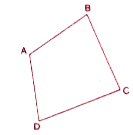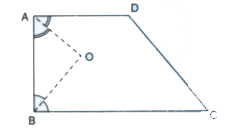If bisectors of ∠Aand∠B of a quadrilateral ABCD intersect each other at P, of ∠Band∠C at Q, of ∠Cand∠D of R and of ∠Dand∠A at S, then PQRS is a (A) Rectangle (B) Rhombus (C) Parallelogram (D) Quadrilateral whose opposite angles are supplementary
rectangle
rhombus
parallelogram
quadrilateral whose opposite angles are supplementary
The correct Answer is:D
To solve the problem, we need to analyze the properties of the angles formed by the angle bisectors of a quadrilateral ABCD. Let's go through the solution step by step.
1. Understanding the Quadrilateral and the Bisectors:
- We have a quadrilateral ABCD.
- The angle bisectors of angles A and B intersect at point P, B and C at Q, C and D at R, and D and A at S.
2. Identifying Vertically Opposite Angles:
- We know that angle QPS is equal to angle APB because they are vertically opposite angles.
3. Applying the Angle Sum Property:
- In triangle APB, we can apply the angle sum property:
Angle APB+12Angle A+12Angle B=180∘
- Rearranging gives us:
Angle APB=180∘−(12Angle A+12Angle B)
- We can label this as Equation (1).
4. Finding Angle QPS:
- Since angle QPS = angle APB, we can substitute from Equation (1):
Angle QPS=180∘−(12Angle A+12Angle B)
- We can label this as Equation (2).
5. Repeating for Angle QRS:
- Similarly, we can find angle QRS:
Angle QRS=180∘−(12Angle C+12Angle D)
- We can label this as Equation (3).
6. Summing Angles QPS and QRS:
- Now, we can sum angles QPS and QRS:
Angle QPS+Angle QRS=(180∘−(12Angle A+12Angle B))+(180∘−(12Angle C+12Angle D))
- This simplifies to:
Angle QPS+Angle QRS=360∘−(12(Angle A+Angle B+Angle C+Angle D))
7. Using the Angle Sum Property of Quadrilaterals:
- We know that the sum of angles in a quadrilateral is 360 degrees:
Angle A+Angle B+Angle C+Angle D=360∘
- Therefore:
12(Angle A+Angle B+Angle C+Angle D)=180∘
- Substituting this back gives:
Angle QPS+Angle QRS=360∘−180∘=180∘
8. Conclusion:
- Since the sum of angles QPS and QRS is 180 degrees, we can conclude that the quadrilateral PQRS has opposite angles that are supplementary.
- Thus, the answer is:
(D) Quadrilateral whose opposite angles are supplementary.
- We have a quadrilateral ABCD.
- The angle bisectors of angles A and B intersect at point P, B and C at Q, C and D at R, and D and A at S.
- We know that angle QPS is equal to angle APB because they are vertically opposite angles.
- In triangle APB, we can apply the angle sum property:
Angle APB+12Angle A+12Angle B=180∘
- Rearranging gives us:
Angle APB=180∘−(12Angle A+12Angle B)
- We can label this as Equation (1).
- Since angle QPS = angle APB, we can substitute from Equation (1):
Angle QPS=180∘−(12Angle A+12Angle B)
- We can label this as Equation (2).
- Similarly, we can find angle QRS:
Angle QRS=180∘−(12Angle C+12Angle D)
- We can label this as Equation (3).
- Now, we can sum angles QPS and QRS:
Angle QPS+Angle QRS=(180∘−(12Angle A+12Angle B))+(180∘−(12Angle C+12Angle D))
- This simplifies to:
Angle QPS+Angle QRS=360∘−(12(Angle A+Angle B+Angle C+Angle D))
- We know that the sum of angles in a quadrilateral is 360 degrees:
Angle A+Angle B+Angle C+Angle D=360∘
- Therefore:
12(Angle A+Angle B+Angle C+Angle D)=180∘
- Substituting this back gives:
Angle QPS+Angle QRS=360∘−180∘=180∘
- Since the sum of angles QPS and QRS is 180 degrees, we can conclude that the quadrilateral PQRS has opposite angles that are supplementary.
- Thus, the answer is:
(D) Quadrilateral whose opposite angles are supplementary.
Topper's Solved these Questions
- BOOK - NCERT EXEMPLAR ENGLISHCHAPTER - QUADRILATERALS EXERCISE - VERY SHORT ANSWER TYPE QUESTIONS14videos
QUADRILATERALS
- BOOK - NCERT EXEMPLAR ENGLISHCHAPTER - QUADRILATERALS EXERCISE - SHORT ANSWER TYPE QUESTIONS10videos
QUADRILATERALS
- BOOK - NCERT EXEMPLAR ENGLISHCHAPTER - POLYNOMIALSEXERCISE - EXERCISE 2.4 Long Answer type Questions9videos
POLYNOMIALS
- BOOK - NCERT EXEMPLAR ENGLISHCHAPTER - STATISTICS AND PROBABILITYEXERCISE - LONG ANSWER TYPE QUESTIONS12videos
STATISTICS AND PROBABILITY
Similar Questions
Bisectors of angles A and D of a quadrilateral ABCD meet at P. Prove that ∠APD=12(∠B+∠C)
View SolutionDiagonals of a quadrilateral ABCD bisect each other. If ∠A=35∘, determine ∠B.
View SolutionThe bisectors of ∠Band∠C of a quadrilateral ABCD intersect each other at point P. Show that P is equidistant from the opposite sides AB and CD.
View SolutionBisectors of angles A and B of a parallelogram ABCD meet at point M. Prove that ∠AMB=12(∠C+∠D)
View SolutionIn a quadrilateral ABCD the linesegment bisecting ∠Cand∠D meet at E. Prove that ∠A+∠B=2∠CED.
View SolutionA quadrilateral whose each angle is a right angle is a (a) square (b) rectangle (c) rhombus (d) parallelogram
View SolutionIf the bisectors of two adjacent angles A and B of a quadrilateral ABCD intersect at a point O such that ∠C+∠D=k∠AOB, then find the value of k.
View SolutionIn quadrilateral ABCD, AB is the shortest side and DC is the longest side. Prove that :
(i) ∠B>∠D
(ii) ∠A>∠C
 View Solution
View SolutionIn a quadrilateral ABCD, AO and BO are bisector of angle A and angle B resepectively. Show that :
∠AOB=12(∠C+∠D) View Solution
View SolutionA quadrilateral having each angle is a right angle and whose all sides are equal is a (a) square (b) rectangle (c) rhombus (d) parallelogram
View Solution

